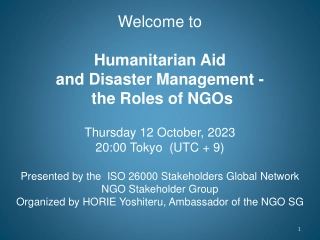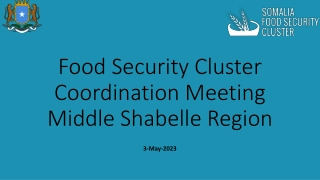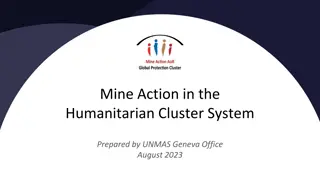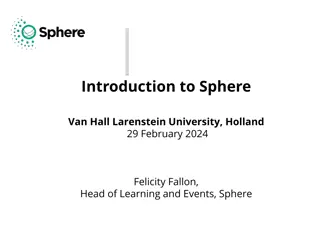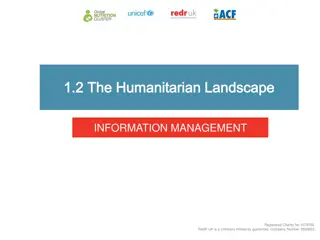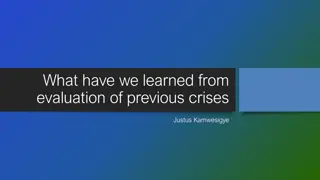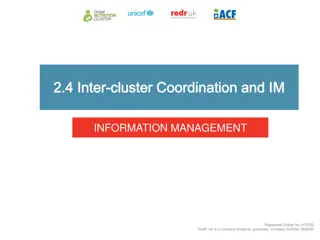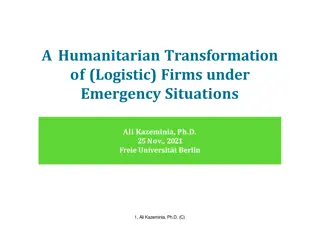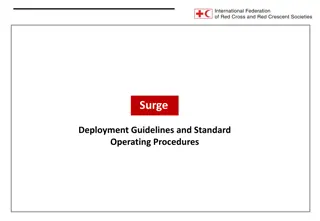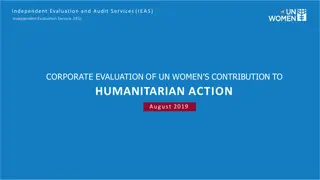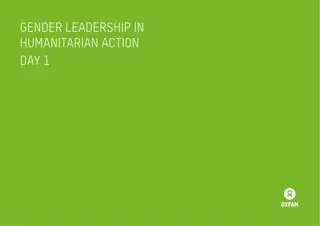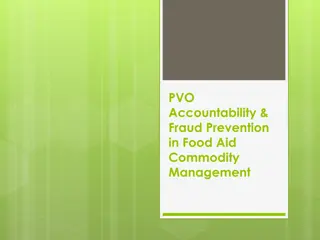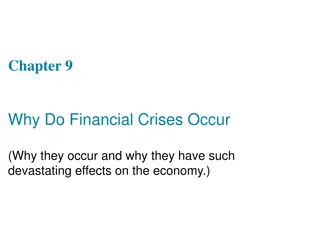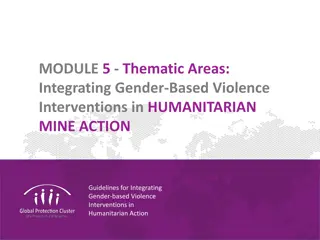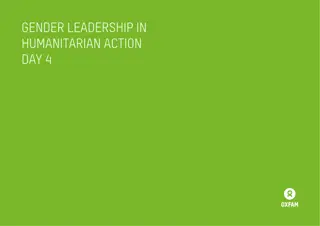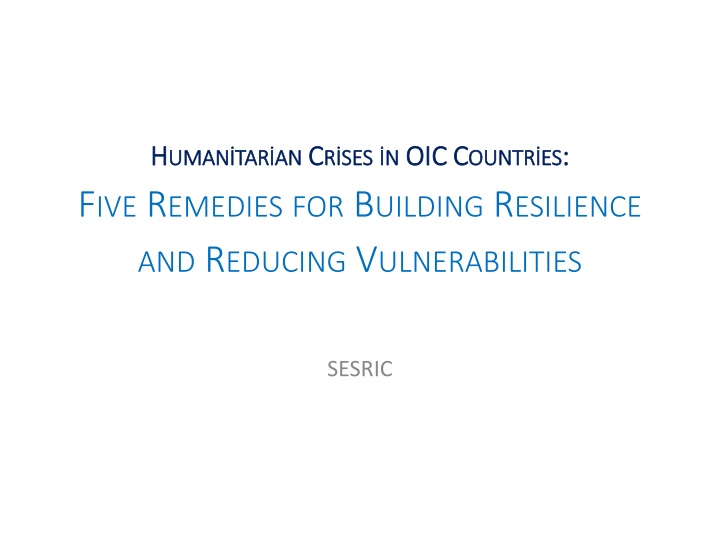
Building Resilience and Reducing Vulnerabilities: Key Strategies
Discover how OIC countries can combat the rising humanitarian crises through building resilience and reducing vulnerabilities. Learn about the challenges faced and the five sets of actions recommended for addressing the increasing conflicts, natural disasters, and displacement crises.
Download Presentation

Please find below an Image/Link to download the presentation.
The content on the website is provided AS IS for your information and personal use only. It may not be sold, licensed, or shared on other websites without obtaining consent from the author. If you encounter any issues during the download, it is possible that the publisher has removed the file from their server.
You are allowed to download the files provided on this website for personal or commercial use, subject to the condition that they are used lawfully. All files are the property of their respective owners.
The content on the website is provided AS IS for your information and personal use only. It may not be sold, licensed, or shared on other websites without obtaining consent from the author.
E N D
Presentation Transcript
H HUMAN UMAN TAR AN C CR R SES SES N N OIC OIC C COUNTR ES OUNTR ES: : TAR AN FIVE REMEDIES FOR BUILDING RESILIENCE AND REDUCING VULNERABILITIES SESRIC
Outline Outline Surge Surge in the number of humanitarian crises in OIC countries Increase in natural disasters and conflicts Lack Lack of capacity at community, national and international level to address the challenges Significant gaps in financing humanitarian development and good governance Need Need for OIC countries to develop their own mechanisms to build resilience and reduce vulnerability Five sets of actions for building resilince and reducing vulnerabilities
Surge in Humanitarian Crises Surge in Humanitarian Crises i. Number of conflicts is increasing Conflict Trends 35 OIC Non-OIC 30 Trend line (Non-OIC) 25 Number of Conflicts 20 15 10 Trend line (OIC) 5 0 1970 1972 1974 1976 1978 1980 1982 1984 1986 1988 1990 1992 1994 1996 1998 2000 2002 2004 2006 2008 2010 2012 2014 Source: SESRIC staff calculations based on the Uppsala Conflict Database
Surge in Humanitarian Crises Surge in Humanitarian Crises ii. Number of natural disasters is increasing Total Number of Natural Disasters over Time (1970-2014) OIC Rest of the World WORLD 600 500 400 300 200 100 0 1970 1971 1972 1973 1974 1975 1976 1977 1978 1979 1980 1981 1982 1983 1984 1985 1986 1987 1988 1989 1990 1991 1992 1993 1994 1995 1996 1997 1998 1999 2000 2001 2002 2003 2004 2005 2006 2007 2008 2009 2010 2011 2012 2013 2014 Source: SESRIC staff calculations based on EM-DAT: The OFDA/CRED International Disaster Database
Surge in Humanitarian Crises Surge in Humanitarian Crises iii. Number of displaced people is increasing Total Displacement in OIC and Non-OIC Countries Total Internally Displaced Persons (IDPs) Protected/Assisted by UNHCR OIC OIC Non-OIC Total 15,721,632; 41.1% Non-OIC 21.5 19.4 Only 2014 13.5 12.9 12.5 4,398,844; 40% 10.8 6,586,034; 60% 22,485,560; 58.9% Start-2014 End-2014 Mid-2015 Source: Internal Displacement Monitoring Centre (IDMC) Source: UNHCR
Lack of Capacity Lack of Capacity i. Lack of good governance and more fragile states The The Worldwide Governance Indicator, Government Worldwide Governance Indicator, Government Effectiveness Effectiveness Distribution Distribution of Fragile State Index, 2015 of Fragile State Index, 2015 Distribution of Fragile State Index, 2015 .04 2.0 1.44 1.5 .03 Government Effectiveness 1.0 Density .02 0.5 .01 0.0 0 Very Sustainable -0.14 Very High Alert -0.5 20 40 60 Fragile State Index 80 100 120 -0.57 -1.0 OIC Non-OIC Developing Developed OIC Countries Non-OIC Developing Countries Developed Countries Source: SESRIC staff calculations based on the World Governance Indicators, 2015 Update
Lack of Capacity Lack of Capacity ii. Lower levels of human development Human Development Index Human Development Index (2014 vs 2000; OIC vs Non-OIC Developing) 4 High (14 OIC Countries) Very High (6 OIC Countries) Low (23 OIC countries) Medium (13 OIC Countries) 3 Density 2 1 0 .2 .3 .4 .5 .6 .7 .8 .9 1 Human Development Index Value OIC Countries, 2014 Non-OIC Developing Countries, 2014 OIC Countries, 2000
Lack of Capacity Lack of Capacity iii. High welfare inequality 0.48 m (0.05%) USD 1.9 trillion (23.3%) > USD 1 million Wealth Wealth Pyramid of OIC Pyramid of OIC Countries (2014) Countries (2014) 8.3 m USD 100,000 to 1 m USD 1.9 trillion (23.4%) (0.9%) 105.5 m USD 2.7 trillion (33.2%) USD 10,000 to 100,000 (11.6%) USD 1.6 trillion (20.1%) < USD 10,000 798.1 m (87.5%) Total wealth (% Total wealth (% of OIC) of OIC) Wealth Wealth range range Number of adults (% of OIC population) Number of adults (% of OIC population) Source: SESRIC staff calculation based on data provided by Credit Suisse on Global Wealth for 2014.
Lack of Capacity Lack of Capacity iv. Vulnerability vs Hazard & Exposure Index in OIC Countries (2015) Hazard & Exposure Index (2015) Vulnerability Index (2015) Source: Index for Risk Management (INFORM) , www.inform-index.org/
Lack of Capacity Lack of Capacity v. Vulnerability vs Lack of Coping Capacity Index in OIC Countries (2015) Lack of Coping Capacity Index (2015) Vulnerability Index (2015) Source: Index for Risk Management (INFORM) , www.inform-index.org/
Five Sets of Actions Five Sets of Actions i. Promote inclusive societies and inclusive development ii. Strengthen social capital, mediation and partnership iii. Invest in human capital and facilitate social mobility iv. Intensify disaster risk reduction and management practices v. Mobilize innovative financing mechanisms for humanitarian aid and development assistance
Five Sets of Actions Five Sets of Actions i. Promote inclusive societies and inclusive development Institutional Institutional Quality and Governance (2014) Quality and Governance (2014) a) a) Ensure fair distribution of welfare and Ensure fair distribution of welfare and inclusive growth inclusive growth OIC Developed Other Developing Rule of Law b) b) Improve the transparency, Improve the transparency, accountability and responsiveness of accountability and responsiveness of institutions for good governance institutions for good governance 2.5 1.5 Voice and Accountability 0.5 Corruption -0.5 -1.5 -2.5 c) c) Enhance inclusive decision making and Enhance inclusive decision making and support civil society activities support civil society activities Government Effectiveness Regulatory Quality Political Stability d) d) Ensure equal access to public Ensure equal access to public infrastructure and services infrastructure and services
Five Sets of Actions Five Sets of Actions ii. Strengthen social capital, mediation and partnership a) a) Strengthen social capital and eliminate Strengthen social capital and eliminate discrimination of people discrimination of people Conflict Conflict Vulnerability Index, Levels of Fragility (2015) Vulnerability Index, Levels of Fragility (2015) Alert Warning Stable Sustainable 7% b) b) Improve local and institutional capacity Improve local and institutional capacity for conflict prevention for conflict prevention 12% 28% 56% c) c) Ensure effective mediation for Ensure effective mediation for peacebuilding and post peacebuilding and post- -conflict recovery conflict recovery 45% d) d) Encourage volunteerism for a sense of Encourage volunteerism for a sense of common obligation common obligation 37% 14% e) e) Promote regional partnership for Promote regional partnership for cooperation cooperation OIC Non-OIC Source: SESRIC staff calculation based on The Fund for Peace FSI Index.
Five Sets of Actions Five Sets of Actions iii. Invest in human capital and facilitate social mobility Literacy Literacy Rates Rates Adult Total A. Female A. Male a) a) Strengthen health systems for Strengthen health systems for resilience resilience 99 98 97 88 86 83 80 79 78 75 72 64 b) b) Improve accessibility and Improve accessibility and quality of education quality of education OIC Other Developing Developed World c) c) Invest in skills development Invest in skills development and enhance employability and enhance employability Skills Skills Levels Levels OIC Non-OIC Developing Developed 69% d) d) Address the challenges of Address the challenges of youth youthand and disadvantaged disadvantaged groups groups 68% 51% 39% 19% 17% 15% 13% 10% Low Skills Medium Skills High Skills
Five Sets of Actions Five Sets of Actions iv. Intensify disaster risk reduction and management practices a) a) Expedite the efforts for climate change Expedite the efforts for climate change adaptation adaptation Vulnerability Vulnerability to Disasters to Disasters Very High High Medium Low Very Low 100% b) b) Adopt a policy shift from response to Adopt a policy shift from response to prevention and mitigation prevention and mitigation 3 2 90% 13 80% 29 c) c) Integrate disaster risk management Integrate disaster risk management concerns into national development concerns into national development planning planning 70% 8 60% 30 14 50% 13 40% d) d) Strengthen the capacity of the institutions Strengthen the capacity of the institutions for disaster risk management for disaster risk management 21 30% 20% 18 10% 16 4 e) e) Improve strategic planning for response Improve strategic planning for response and recovery, and invest in local capacities and recovery, and invest in local capacities 0% OIC Developed Non-OIC Developing
Five Sets of Actions Five Sets of Actions v. Mobilize innovative financing mechanisms for humanitarian aid and development assistance a) a) Improve aid effectiveness and reduce Improve aid effectiveness and reduce aid dependency aid dependency Humanitarian Humanitarian Response Plans 2015 Response Plans 2015 Requirements Funding % Covered 16 55% b) b) Develop alternative financial Develop alternative financial mechanisms for building resilience mechanisms for building resilience 14 54% 12 c) c) Utilize Islamic social finance for Utilize Islamic social finance for humanitarian aid and development humanitarian aid and development assistance assistance Billions 10 53% 8 52% 6 4 51% d) d) Strengthen Strengthen collaboration between OIC collaboration between OIC and the UN Institutions on Islamic and the UN Institutions on Islamic social finance for humanitarian actions social finance for humanitarian actions 2 0 50% OIC Non-OIC
Call for Accelarated Action Call for Accelarated Action The proposed remedies for reducing vulnerabilities and building resilience in OIC countries are mostly long mostly long- -term solutions term solutions to humanitarian crises These solutions can be better realized if specific targets and timeframe are set. However, there is a need for immediate action. Multilateral partnership is critical for resolving discrete challenges. There is a need to build a new cooperation paradigm of interdependent relationships. Exit strategies should be developed to prevent protraction Embarking on own potential to solve own problems could be highly effective Everyone has a role to play
H HUMANITARIAN UMANITARIAN C CRISES F FIVE IVE R REMEDIES EMEDIESFOR RISESIN IN OIC C FOR B BUILDING UILDING R RESILIENCE OIC COUNTRIES OUNTRIES: : ESILIENCEAND AND R REDUCING EDUCING V VULNERABILITIES ULNERABILITIES Thank you for your attention DISCUSSIONS DISCUSSIONS

